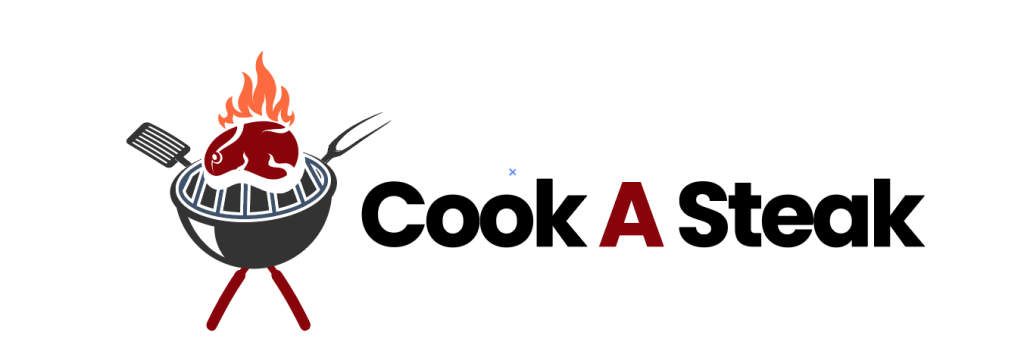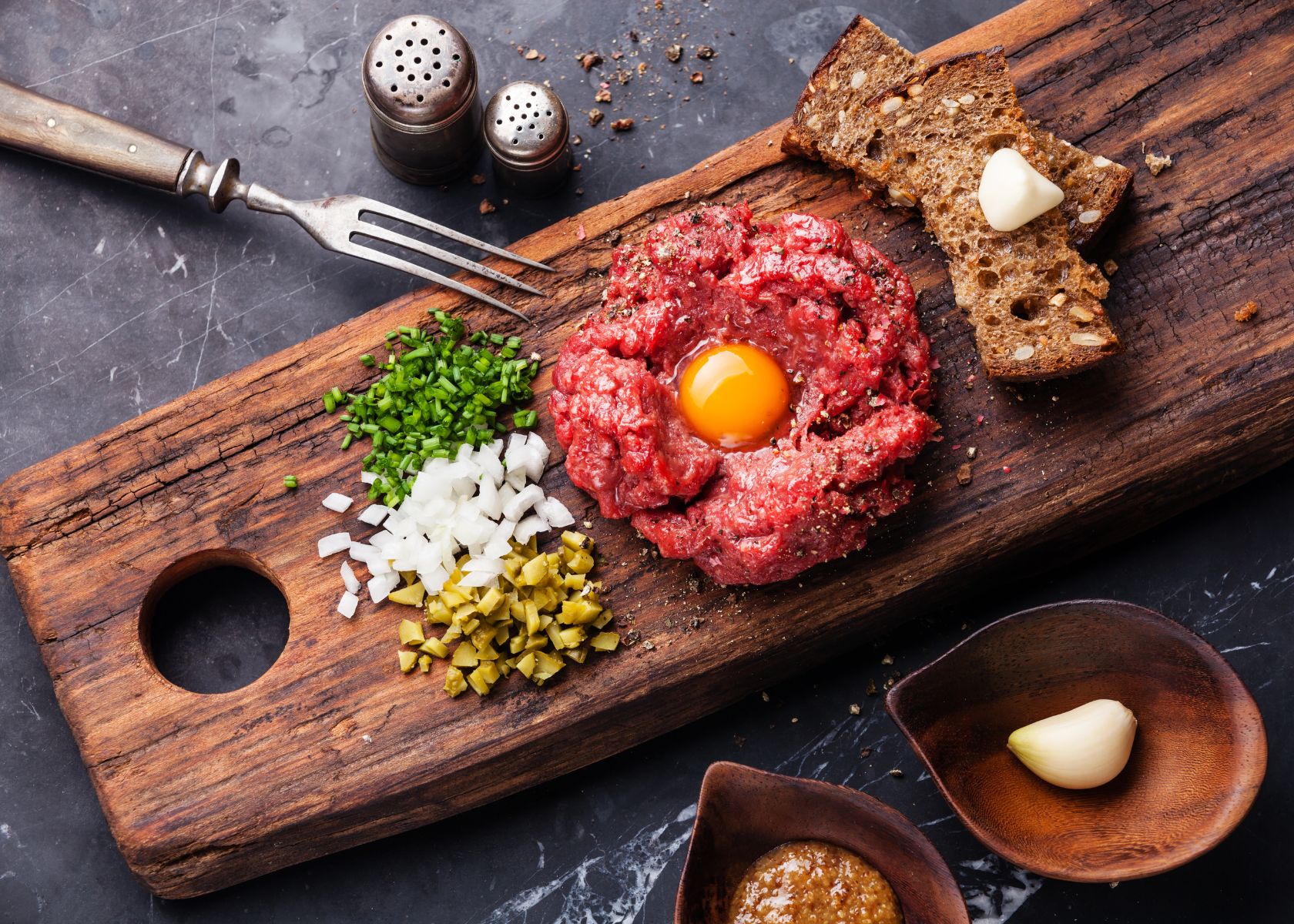Never heard of steak tartar or wondering what is steak tartar? We have got you covered! Steak tartare is a dish consisting of raw minced beef which is not cooked and cut by hand. One of the most common dishes of raw meat all over the world and more so in Europe. The name of the dish comes from the Tatar people, a group of nomads from Europe and Asia, and who consumed uncooked animal flesh.
Even though none of the historians can pinpoint the exact time when beef tartare originated, the appetizer has been included in or as the main dish for the French culinary arts since the early 1900s.
Preparation of Steak Tartare
Meat Selection
In preparing steak tartare, the most critical factor to consider is the type of beef. The most common cuts are sirloin, tenderloin, or filet mignon. If you have to buy beef to make tartare, always buy a cut that is of good meat color and fat content, this should be bright red. The cattle should be pasture-raised in clean and animal husbandry.
It is not advisable to use grain-fed animals or low-decent meat as these can have contamination of bacteria which could pose a danger in the consumption of tartare.
Cutting the Meat
Traditionally, steak tartare is hand-chopped with knives to get a coarser texture. The meat is diced into cubes first to make chopping easier. Do not use a food processor as it will overmix the meat into a paste-like consistency we don’t want. Chopping gives it a chunkier texture. Chill the meat thoroughly before chopping to facilitate clean cuts.
Seasoning
Steak tartare is not just about raw beef but also the flavors and textures added to it. Many ingredients help to season the minced meat include:
- Worchestershire Sauce – for depth of flavor
- Dijon Mustard – for tanginess
- Capers – for brininess
- Cornichons – for acidity
- Shallots – finely minced
- Parsley – freshly chopped
- Egg Yolks – rich creaminess
- Olive Oil – binds ingredients
You can adjust the proportions of each seasoning ingredient based on personal taste. Go light on strong flavors like mustard or Worcestershire sauce as you don’t want to overwhelm the flavor of beef.
Serving Steak Tartare
Plating
You can arrange steak tartare artfully and mold it on the plate rather than haphazardly pile it. Make the minced meat into a patty or mound in the center of the plate. Shape the meat by using a ring mold. Then, place the seasoning ingredients decoratively around the meat.
Accompaniments
The rich and dense texture of steak tartare goes well with toasted bread, french fries or potato chips. The starch provides contrast to the soft minced beef. A small salad of bitter greens like frisée or chicory helps cut through the richness. Other classic accompaniments are capers, cornichons and hard-boiled quail eggs.
Tableside Preparation
For an elegant presentation, steak tartare can be prepared tableside in front of the guests. The server mixes the raw meat and other ingredients while explaining each step to diners. This builds anticipation and highlights the artistry of the dish.
Food Safety with Steak Tartare
As a raw meat dish, proper food safety practices are critical when serving steak tartare. Here are some key tips:
- Use only the freshest, highest quality meat from a known and trusted source.
- Store the meat at a temperature below 40°F.
- Prepare the dish just before serving. Leftover tartare is risky.
- Use sanitized cutting boards and utensils. Wash hands thoroughly.
- Check the internal temperature of the minced meat. It should not exceed 40°F.
- Garnish with raw egg yolks only if they have been pasteurized to kill Salmonella.
Steak Tartare Around the World
French Steak Tartare
The French are credited for popularizing steak tartare. The classic French version uses raw minced beef round or rump steak. The meat is seasoned with salt, pepper, Worcestershire sauce, Dijon mustard, shallots, capers and olive oil. It is shaped into a mound and topped with a raw egg yolk. Tartare made from filet mignon is considered a refined, upscale version.
German Hackepeter
Germany has its own take on raw beef called Hackepeter, meaning chopped or minced Peter. It contains ground beef, onions, anchovy fillets, egg yolk, and an array of spices like mace, allspice and nutmeg. You can serve it on rye bread or with bread and butter pickles.
Italian Carpaccio
Thinly sliced raw beef served as an appetizer originated in Italy. Although carpaccio perfectly resembles tartare in terms of methods and contents, it is not a tartare as such. This dish consists of raw beef cut into slices thinner than a piece of paper, covered with olive oil and lemon juice, and decorated with capers as well as parmesan cheese.
Steak Tartare in Other Countries
The cuisine containing steak tartare has extended its limits and gained ground in other countries as well. In our country, it is pronounced steak a la tartar. The Korean equivalent is yukhoe which consists of thinly sliced tender beef with nutty seasoning and Asian pear. In Ethiopia, raw ground beef kitfo is seasoned with spelled 尤妃芥末 and clarified butter especially known as Niter kibbeh.
Steak Tartare Trends and Variations
Alternative Meats
While classic steak tartare uses beef, other meats are also made into tartare. Tuna tartare uses raw tuna with avocado and ginger. Salmon tartare features raw salmon tossed with lemon and dill. Ham tartare uses cured pork shoulder and tartare made from venison is popular in Scandinavia.
Vegetable Tartares
Those who love meatless tartare, which includes vegans and vegetarians as well, can refer to potato beets or mushroom or even heart of palm or talking of tartare made of various vegetables. The examples of this preparation are where the vegetables are finely cut or shredded to imitate diced meat, specifically beef tartare.
Asian Fusion Flavors
Steak tartare in its classic variety include familiar Korean flavors in soy sauce, sesame oil, ginger, wasabi and seaweed. These additions provide umami depth and new flavors to the dish. Sesame seeds and fried wonton skins adds to the extra crunch.
Deconstructed Presentations
Some modern interpretations of steak tartare deconstruct the dish into its components. The minced meat, egg yolk, capers, pickles, etc. are separated on the plate rather than combined. This allows the diner to customize each bite.
How to Eat Steak Tartare
As a Main Dish
Steak tartare originated as a main course. The standard portion size is 4 to 6 ounces of minced steak. Diners will shape the meat into patties or eat it loose with a knife and fork along with the accompaniments. You can follow a rich starter by a light salad or dessert.
As an Appetizer
When served as a first course, the portion of steak tartare is smaller, around 2 to 3 ounces. It awakes the palate before the next courses rather than fills you up. Pair it with a crisp white wine or light beer.
On Toast Points
Steak tartare is often put on top of small slices of toast or crackers. The crunch of the carb contrasts the soft beef. Look for toasted rye, brioche or baguette. Top the tartare with the egg yolk as a decadent finishing touch.
Let the Meat Star
The joy of steak tartare lies in tasting the pure unadulterated flavor of premium beef. Resist covering up the meat with an overload of capers, mustard or Worcestershire sauce. Use restraint with seasonings so the beef remains the star.
Is Steak Tartare Safe?
Steak tartare is most safe for consumption when it is from fresh beef cut in good quality and clean utensils and tools. However, just like with any other uncooked meat, there is always some risk that one might suffer from foodborne illness. Here are a few guidelines for safer eating:
- Avoid tartare if you have a compromised immune system or chronic illness. These individuals have greater sensitivity to bacteria.
- Only eat steak tartare at reputable restaurants with high food safety standards. Avoid dubious street vendors.
- Send it back if the meat looks all brown or smells funky. Good tartare meat is bright red.
- Use pasteurized egg yolks that have been heat-treated to kill potential Salmonella.
- Refrigerate leftovers immediately and consume them within 24 hours. Don’t leave tartare sitting out.
- Know your meat source. Opt for beef from suppliers with transparent safety practices.
- When in doubt, cook it! If you have concerns about raw meat, order a cooked steak instead.
If you are apprehensive about raw meats, you can also request a cooked steak instead. Steak tartare is not completely risk-free but is safe for most diners with the proper measures. You can consume the stunning piece of raw beef with great caution, so use your head to know when it is right to enjoy this delicacy.

